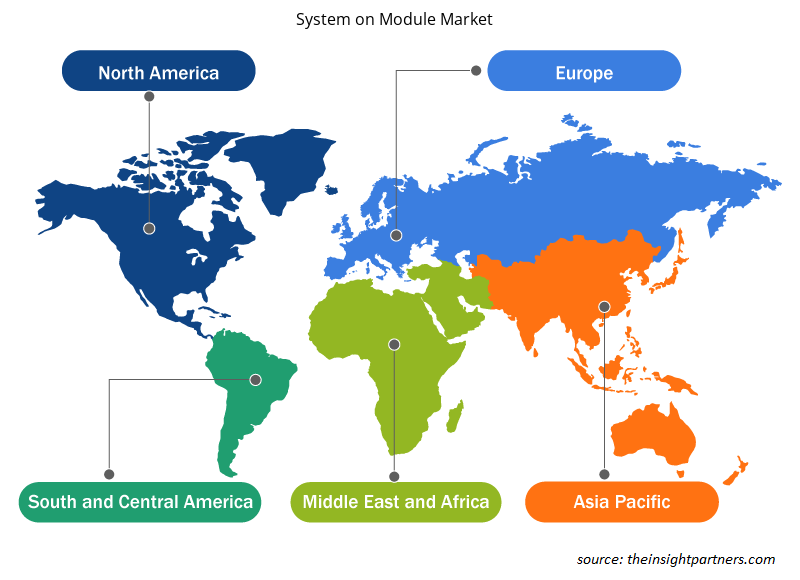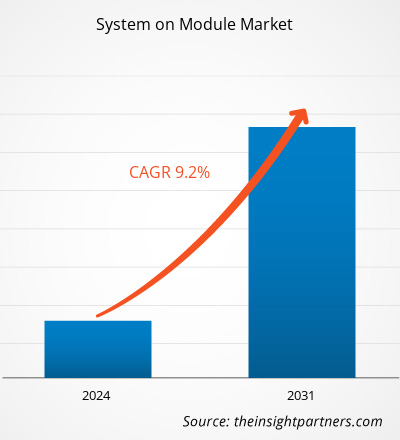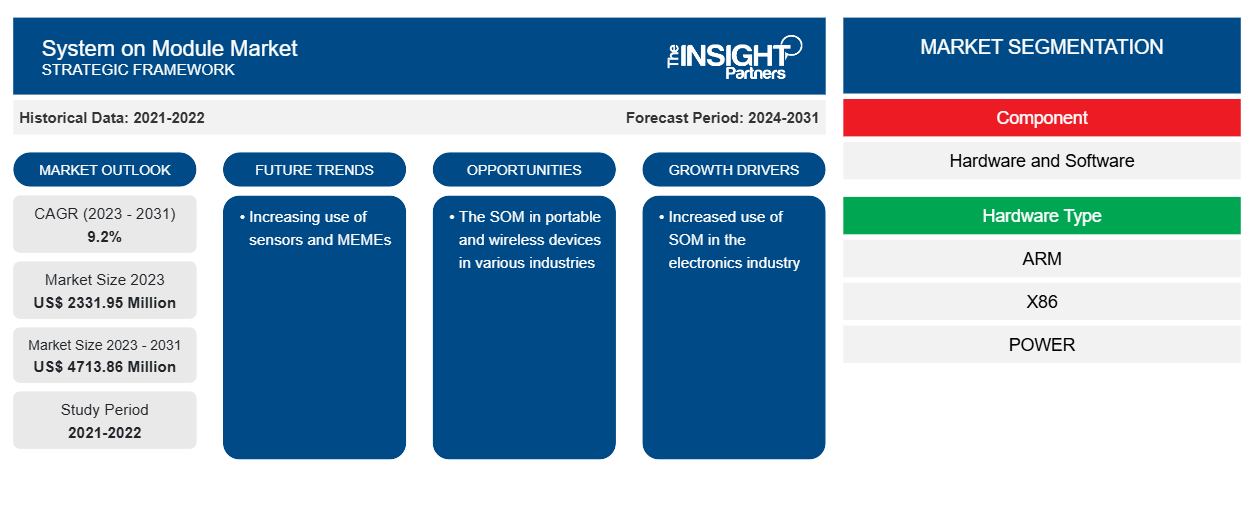Se proyecta que el tamaño del mercado de módulos de sistemas alcance los 4713,86 millones de dólares estadounidenses en 2031, frente a los 2331,95 millones de dólares estadounidenses en 2023. Se espera que el mercado registre una CAGR del 9,2 % durante el período 2023-2031. Es probable que el uso creciente de sensores y MEME siga siendo una tendencia clave en el mercado.
Análisis del mercado de sistemas modulares
El confinamiento mundial para reducir la transmisión del virus ha alterado significativamente las actividades de la cadena de suministro y la capacidad de producción de varios fabricantes, en particular los propietarios de pequeñas y medianas empresas. La industria de los semiconductores contribuyó de manera significativa a la demanda de componentes electrónicos del sector industrial y de los usuarios finales. El modelo de ingresos de la microelectrónica ha disminuido debido a la falta de producción en masa durante el período de confinamiento. La industria de los semiconductores recuperó gradualmente su participación en el mercado a medida que las instalaciones de producción reanudaron sus operaciones mediante la adopción de medidas de distanciamiento social. Además, las estrategias de trabajo desde casa y de supervisión remota también aumentaron las ventas de productos electrónicos avanzados para mejorar la conectividad. Se ha destacado la importancia de la industria de las TI y las telecomunicaciones con fines comunicativos, lo que ha permitido que la industria evolucione con nuevas tecnologías, como la tecnología de embalaje compatible con Wi-Fi de alta velocidad.
Descripción general del mercado de sistemas en módulos
Un sistema en módulo (SOM) presenta los componentes principales de un sistema de procesamiento integrado, como bloques de memoria, interfaces de comunicación y núcleos de procesador, en una única placa de circuito impreso (PCB) lista para producción. Este enfoque modular hace que un SOM sea adecuado para su integración en sistemas finales, desde robots hasta cámaras de seguridad . El concepto de sistema en módulo evolucionó a partir de los servidores blade. Estos servidores delgados se crearon para ahorrar espacio de almacenamiento y reducir el consumo de energía. La arquitectura de los SOM influye en la mentalidad de diseño eficiente que hay detrás de los servidores blade. Incluyen solo los componentes necesarios para su función prevista en un paquete lo más pequeño posible y son lo suficientemente flexibles como para adaptarse a una amplia gama de aplicaciones.
Personalice este informe según sus necesidades
Obtendrá personalización en cualquier informe, sin cargo, incluidas partes de este informe o análisis a nivel de país, paquete de datos de Excel, así como también grandes ofertas y descuentos para empresas emergentes y universidades.
-
Obtenga las principales tendencias clave del mercado de este informe.Esta muestra GRATUITA incluirá análisis de datos, desde tendencias del mercado hasta estimaciones y pronósticos.
Impulsores y oportunidades del mercado de sistemas basados en módulos
Aumento del uso de SOM en la industria electrónica
Como componentes básicos flexibles, los SOM permiten un rápido desarrollo en diversas aplicaciones tecnológicas, desde la electrónica de consumo hasta la automatización industrial, lo que los hace esenciales en el diseño de productos modernos. En el entorno de rápida evolución del diseño de productos electrónicos, la metodología System on Module (SoM) ha surgido como una fuente clave de transformación. Como resultado de su tamaño compacto, alto rendimiento y rentabilidad, el SoM se está convirtiendo en una opción popular entre diseñadores e ingenieros. Por lo tanto, el uso creciente de SOM en la industria electrónica está impulsando el crecimiento del mercado.
El SOM en dispositivos portátiles e inalámbricos en diversas industrias
Los SoM se utilizan en dispositivos médicos portátiles donde la confiabilidad y la compacidad son fundamentales. Por ejemplo, un SoM podría integrarse en un dispositivo de ultrasonido portátil , proporcionando la potencia de procesamiento y la conectividad necesarias en un formato compacto. Los SoM se emplean en sistemas avanzados de asistencia al conductor (ADAS), donde proporcionan capacidades informáticas de alto rendimiento necesarias para el procesamiento en tiempo real de datos de sensores. En entornos industriales, los SoM se utilizan en controladores lógicos programables (PLC) e interfaces hombre-máquina (HMI), ofreciendo soluciones robustas y escalables para tareas de automatización complejas.
Análisis de segmentación del informe de mercado de sistemas en módulos
Los segmentos clave que contribuyeron a la derivación del sistema en el análisis del mercado de módulos son el componente, el tipo de hardware y la aplicación.
- En función del componente, el mercado de sistemas modulares se divide en hardware y software. El segmento de tarjetas de sonda estándar tuvo una mayor participación de mercado en 2023.
- Por tipo de hardware, el mercado está segmentado en ARM, X86, POWER, FPGA, GPU, DSP y RISC-V. El segmento de montaje superficial tuvo una mayor participación de mercado en 2023.
- Por aplicación, el mercado está segmentado en automatización industrial, entretenimiento, medicina, transporte, pruebas y medición, aplicaciones de video y otros.
Análisis de la cuota de mercado de los sistemas modulares por geografía
El alcance geográfico del sistema en el informe del mercado de módulos se divide principalmente en cinco regiones: América del Norte, Asia Pacífico, Europa, Medio Oriente y África, y América del Sur y Central.
La región de Asia Pacífico domina el mercado de sistemas modulares. Muchos de los países de la región se caracterizan por la cantidad de dispositivos electrónicos necesarios para componentes de automoción, dispositivos de telecomunicaciones, productos electrónicos de consumo y otros tipos de maquinaria industrial. El creciente número de empresas de fabricación de productos electrónicos en China y la India, debido a la gran accesibilidad de recursos humanos cualificados, está impulsando el mercado de sistemas modulares.
Perspectivas regionales del mercado de sistemas modulares
Los analistas de Insight Partners explicaron en detalle las tendencias y los factores regionales que influyen en el mercado de sistemas en módulos durante el período de pronóstico. Esta sección también analiza los segmentos y la geografía del mercado de sistemas en módulos en América del Norte, Europa, Asia Pacífico, Oriente Medio y África, y América del Sur y Central.

- Obtenga los datos regionales específicos del sistema en el mercado de módulos
Alcance del informe de mercado de sistemas modulares
| Atributo del informe | Detalles |
|---|---|
| Tamaño del mercado en 2023 | US$ 2331,95 millones |
| Tamaño del mercado en 2031 | US$ 4713,86 millones |
| CAGR global (2023 - 2031) | 9,2% |
| Datos históricos | 2021-2022 |
| Período de pronóstico | 2024-2031 |
| Segmentos cubiertos |
Por componente
|
| Regiones y países cubiertos |
América del norte
|
| Líderes del mercado y perfiles de empresas clave |
|
Densidad de actores del mercado de sistemas modulares: comprensión de su impacto en la dinámica empresarial
El mercado de sistemas modulares está creciendo rápidamente, impulsado por la creciente demanda de los usuarios finales debido a factores como la evolución de las preferencias de los consumidores, los avances tecnológicos y una mayor conciencia de los beneficios del producto. A medida que aumenta la demanda, las empresas amplían sus ofertas, innovan para satisfacer las necesidades de los consumidores y aprovechan las tendencias emergentes, lo que impulsa aún más el crecimiento del mercado.
La densidad de actores del mercado se refiere a la distribución de las empresas o firmas que operan dentro de un mercado o industria en particular. Indica cuántos competidores (actores del mercado) están presentes en un espacio de mercado determinado en relación con su tamaño o valor total de mercado.
Las principales empresas que operan en el mercado de sistemas en módulos son:
- Tecnología de microchip
- Cª
- Compañía Advantech Ltd.
- Laboratorios SoML
- Compañía Axiomtek Ltd.
- Conectar tecnología inc.
Descargo de responsabilidad : Las empresas enumeradas anteriormente no están clasificadas en ningún orden particular.

- Obtenga una descripción general de los principales actores clave del mercado del sistema en módulo
Noticias y desarrollos recientes del mercado de sistemas modulares
El sistema en el mercado de módulos se evalúa mediante la recopilación de datos cualitativos y cuantitativos a partir de una investigación primaria y secundaria, que incluye publicaciones corporativas importantes, datos de asociaciones y bases de datos. A continuación se enumeran algunos de los avances en el sistema en el mercado de módulos:
- Toradex, un proveedor líder de soluciones de sistemas integrados, lanzó su nueva familia de sistemas en módulos (SoM) escalables y compatibles con pines: Aquila. (Fuente: Toradex, comunicado de prensa, abril de 2024)
- NetBurner anunció el lanzamiento de su última solución, el sistema en módulo (SOM) SOMRT1061. Con un rendimiento excelente en un tamaño pequeño de 25,4 mm, es ideal para usar como procesador principal del sistema, subprocesador de red o incluso como servidor serial a Ethernet cifrado. (Fuente: NetBurner, comunicado de prensa, mayo de 2024)
Informe de mercado sobre sistemas modulares: cobertura y resultados
El informe “Tamaño y pronóstico del mercado de sistemas en módulos (2021-2031)” proporciona un análisis detallado del mercado que cubre las siguientes áreas:
- Sistema sobre el tamaño del mercado de módulos y pronóstico a nivel global, regional y nacional para todos los segmentos clave del mercado cubiertos bajo el alcance
- Tendencias del mercado de sistemas sobre módulos, así como dinámicas del mercado, como impulsores, restricciones y oportunidades clave
- Análisis detallado de las cinco fuerzas de Porter y PEST y FODA
- Análisis del mercado de sistemas modulares que abarca las tendencias clave del mercado, el marco global y regional, los principales actores, las regulaciones y los desarrollos recientes del mercado
- Análisis del panorama de la industria y de la competencia que abarca la concentración del mercado, el análisis de mapas de calor, los actores destacados y los desarrollos recientes del mercado de sistemas en módulos
- Perfiles detallados de empresas
- Análisis histórico (2 años), año base, pronóstico (7 años) con CAGR
- Análisis PEST y FODA
- Tamaño del mercado, valor/volumen: global, regional y nacional
- Industria y panorama competitivo
- Conjunto de datos de Excel
Informes recientes
Testimonios
Razón para comprar
- Toma de decisiones informada
- Comprensión de la dinámica del mercado
- Análisis competitivo
- Información sobre clientes
- Pronósticos del mercado
- Mitigación de riesgos
- Planificación estratégica
- Justificación de la inversión
- Identificación de mercados emergentes
- Mejora de las estrategias de marketing
- Impulso de la eficiencia operativa
- Alineación con las tendencias regulatorias























 Obtenga una muestra gratuita para - Sistema en el mercado de módulos
Obtenga una muestra gratuita para - Sistema en el mercado de módulos